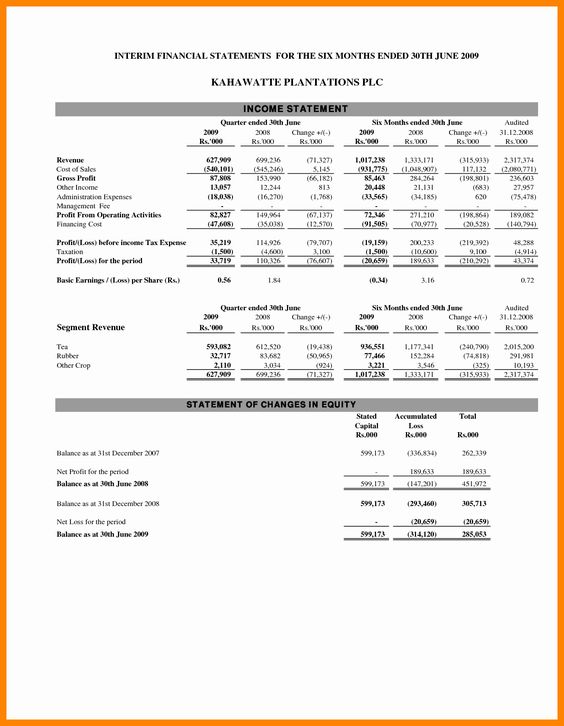We all know that companies prepare their statements at the end of an accounting period, which is usually a year. However, waiting till the end of the year before getting a financial report, may omit loopholes that businesses need to deal with. So to avoid this, businesses use the interim financial statements. An interim statement is a financial report that covers a period of less than one year. That being said, this article will reveal some of the examples, samples, and templates of interim financial statements. Without further all do, let’s get down to business.
What are Interim Financial Statements?
An interim financial statement is a financial report that covers a period of less than one year. However, they are used to carry a company’s performance before the end of the complete financial reporting year. They also increase communication between companies and the public. Also, they provide investors with updated information between annual reporting periods.
Furthermore, public companies often apply this concept which must issue these statements at quarterly intervals. These firms issue three sets of interim statements per year, which are for the first, second, and third quarters. An organization’s financial report for a year is not the same as an interim statement.
The interim statement concept can apply to any period, such as the last six months. Generally, the “interim” concept does not affect the balance sheet. This is because this financial statement only refers to assets, liabilities, and equity as of a specific point in time, rather than over a period of time.
Nevertheless, Interim financial statements comprise the same documents in the annual financial statements. That is the income statement, balance sheet, and statement of cash flows. The line items in these documents are also the ones in the annual financial statements. Also, a quarterly report is an example of an interim statement because it is issued before year-end.
Interim Statement Vs Annual Statement
The key differences between interim and annual statements are in the following areas:
#1, Disclosures
Also, in an interim statement, some disclosures are not needed or can be done in a more summarized format.
#2. Seasonality
Seasonality often has an impact on the revenues made by a business. If so, interim statements may show periods of major losses and profits. However, these are not clear in the annual financial statements.
#3. Accrual basis
The basis for accrual expenses can vary within interim reporting periods. For example, an expense could be recorded within one reporting period. This can make the financial positions within the interim periods appear inconsistent when reviewed on a comparative basis.
Interim Financial Statements Examples
As said earlier, the most common example of an interim financial statement may be the quarterly report. It is a summary of un-audited financial statements, such as balance sheets, and income statements issued by companies every quarter. However, these statements may also give year-to-date and comparative (e.g., last year’s quarter to this year’s quarter) results.
Let us take an example of the ABC credit agency. The agency plans to release its quarterly report for the First Quarter. However, they have asked its company secretary to make a draft of this report. Also, all the financial details have been shared with the ABC credit agency. Thus, help the company secretary to prepare this report.
Message from the board,
The board of directors has approved the release of unaudited financial statements for the Quarter ending 31/03/2019. However, the board is glad to share financials with positive numbers with the stakeholders. The board has taken up extra strategic actions that would further help in promoting the financial conditions of the business.
For Quarter ending 1, the balance sheet is as follows:
| Particular | 31/03/2021 | 31/03/2020 |
| Cash | $20,000 | $15,000 |
| Marketable Securities | $40,000 | $50,000 |
| Inventories | $22,0000 | $20,000 |
| Total Current Assets | $82,000 | $85,000 |
| Net PPE | $45,000 | $60,000 |
| Total Assets | $127,000 | $145,000 |
| Accounts Payable | $30,000 | $20,000 |
| Accruals | $17,000 | $18,000 |
| Current Portion of Debt | $20,000 | $24,000 |
| Total Current Liabilities | $67,000 | $62,000 |
| Long Term Debt | $2,0000 | $43,000 |
| Total Equity | $4,0000 | $40,000 |
| Total Liabilities | $12,700 | $145,000 |
| Sales | $20,000 | $15,000 |
| Cost of Sales | $8,000 | $9,500 |
| Gross Profit | $12,000 | $5,500 |
| Operating Expenses | $7,000 | $2,000 |
| Net Income | $5000 | $3,300 |
Interim Financial Statements Templates
The interim financial statements template and sample have a vital impact in understanding this topic. Nevertheless, here is a sample of the interim financial statement template.

Interim Financial Statements Pdf
In addition, there is a PDF showing the Interim Financial Statements
Disclaimer
This pdf given above is not sponsored by Business Yield. It’s only for informative purposes. Therefore, Business Yields will not be liable for its usage.
Conclusion
In conclusion, an interim statement is vital for every organization for them to solve problems early. However, the interim statement concept can apply to any period, such as the last six months. Generally, the “interim” concept does not affect the balance sheet.
Interim Financial Statements FAQ
What do you mean by interim reporting?
An interim financial statement is a financial report that covers a period of less than one year. They are used to carry a company’s performance before the end of the complete financial reporting year.
How do you prepare an interim financial statement?
It is a summary of un-audited financial statements, such as balance sheets, and income statements issued by companies every quarter.






